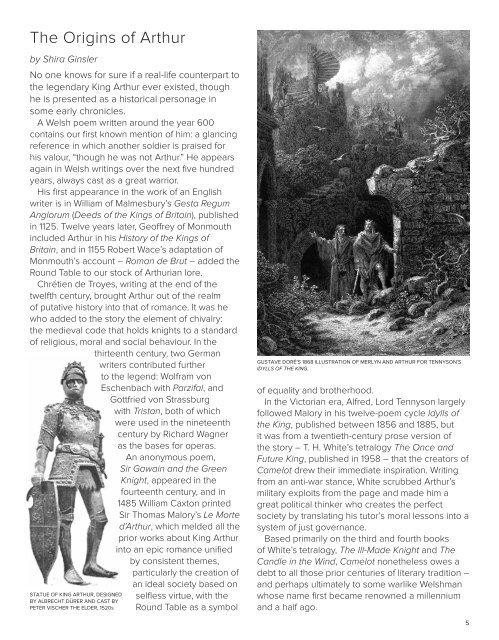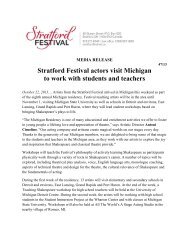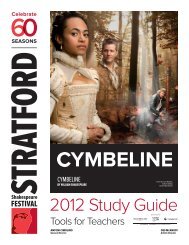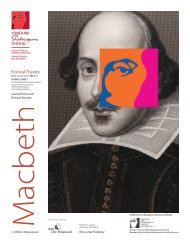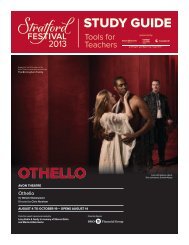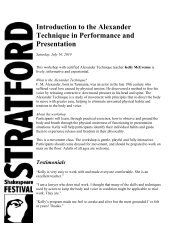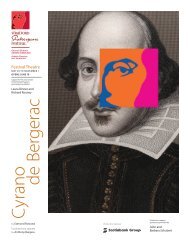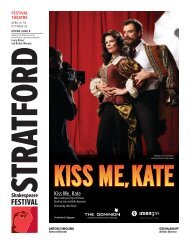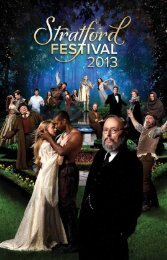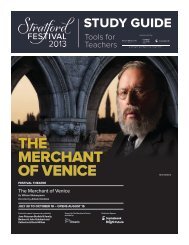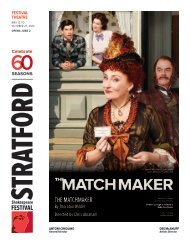CameLot - Stratford Festival
CameLot - Stratford Festival
CameLot - Stratford Festival
Create successful ePaper yourself
Turn your PDF publications into a flip-book with our unique Google optimized e-Paper software.
The Origins of Arthurby Shira GinslerNo one knows for sure if a real-life counterpart tothe legendary King Arthur ever existed, thoughhe is presented as a historical personage insome early chronicles.A Welsh poem written around the year 600contains our first known mention of him: a glancingreference in which another soldier is praised forhis valour, “though he was not Arthur.” He appearsagain in Welsh writings over the next five hundredyears, always cast as a great warrior.His first appearance in the work of an Englishwriter is in William of Malmesbury’s Gesta RegumAnglorum (Deeds of the Kings of Britain), publishedin 1125. Twelve years later, Geoffrey of Monmouthincluded Arthur in his History of the Kings ofBritain, and in 1155 Robert Wace’s adaptation ofMonmouth’s account – Roman de Brut – added theRound Table to our stock of Arthurian lore.Chrétien de Troyes, writing at the end of thetwelfth century, brought Arthur out of the realmof putative history into that of romance. It was hewho added to the story the element of chivalry:the medieval code that holds knights to a standardof religious, moral and social behaviour. In thethirteenth century, two Germanwriters contributed furtherto the legend: Wolfram vonEschenbach with Parzifal, andGottfried von Strassburgwith Tristan, both of whichwere used in the nineteenthcentury by Richard Wagneras the bases for operas.An anonymous poem,Sir Gawain and the GreenKnight, appeared in thefourteenth century, and in1485 William Caxton printedSir Thomas Malory’s Le Morted’Arthur, which melded all theprior works about King Arthurinto an epic romance unifiedby consistent themes,particularly the creation ofan ideal society based onStatue of King Arthur, designedby Albrecht Dürer and cast byPeter Vischer the Elder, 1520sselfless virtue, with theRound Table as a symbolGustave Doré's 1868 illustration of Merlyn and Arthur for Tennyson’sIdylls of the King.of equality and brotherhood.In the Victorian era, Alfred, Lord Tennyson largelyfollowed Malory in his twelve-poem cycle Idylls ofthe King, published between 1856 and 1885, butit was from a twentieth-century prose version ofthe story – T. H. White’s tetralogy The Once andFuture King, published in 1958 – that the creators ofCamelot drew their immediate inspiration. Writingfrom an anti-war stance, White scrubbed Arthur’smilitary exploits from the page and made him agreat political thinker who creates the perfectsociety by translating his tutor’s moral lessons into asystem of just governance.Based primarily on the third and fourth booksof White’s tetralogy, The Ill-Made Knight and TheCandle in the Wind, Camelot nonetheless owes adebt to all those prior centuries of literary tradition –and perhaps ultimately to some warlike Welshmanwhose name first became renowned a millenniumand a half ago.5


